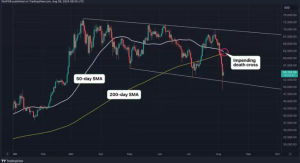The Death Cross of Bitcoin Is Awaiting It Again
Death cross indicators are trailing indicators by nature and have little predictive potential.
The death cross pattern, which caught bears on the wrong side of the market in September of last year, is now in play for the price of bitcoin.
The state of the US economy and the strength of the Japanese yen have a significant impact on Bitcoin’s short-term prospects.
Certain indicators have a tendency to lag and have little predictive ability, yet they are frequently the subject of media attention in both traditional and cryptocurrency markets, which can cause unwarranted anxiety in novice investors.
One such instance is the death cross of bitcoin (BTC), which, in spite of its dismal track record of correctly forecasting future price patterns, frequently provokes increased anxiety and rash responses on social media. Prepare accordingly, since one appears to be approaching.
When the market price of an asset drops below its 200-day simple moving average (SMA), a death cross happens. The 50-day SMA for bitcoin prices is currently declining to $62,332, suggesting a possible crossover with the 200-day SMA, which is currently at $61,605.
The approaching crossover shows that the 50-day SMA, which represents short-term momentum, is failing the long-term average.
This trend is frequently seen as a bearish indication and contributes to catastrophizing, a cognitive distortion that causes novice traders to draw the worst-case scenario, frequently with incomplete knowledge and comprehension.
Overreaction is common, particularly in markets where sentiment is already negative, like the Bitcoin market. In just one week, the cryptocurrency fell more than 20% to $55,000, according to CoinDesk data.
Actually, the chart pattern only depicts the characteristics of the last 50 days’ worth of price movement. It does not imply that subsequent actions will take the same course.
The previous death cross was a significant bear trap, as proven on September 12, 2023. The same day saw the lowest price of Bitcoin, $24,900, and it never recovered, setting new records above $70,000 in March of this year. Those investors who had made plans for additional drops were taken aback.
As CoinDesk noted last year, the preceding nine death crosses have a mixed record, with only five of them indicating protracted downtrends.
In conclusion, the death cross cannot be trusted as a stand-alone indicator. The short-term outlook for bitcoin is mostly influenced by the strength of the US economy and the movement of the Japanese yen.
Carry trades might be further damaged and risk assets, like Bitcoin, could remain under pressure if there is sustained demand for the yen in the foreign exchange markets.
[hurrytimer id=”8423″]




